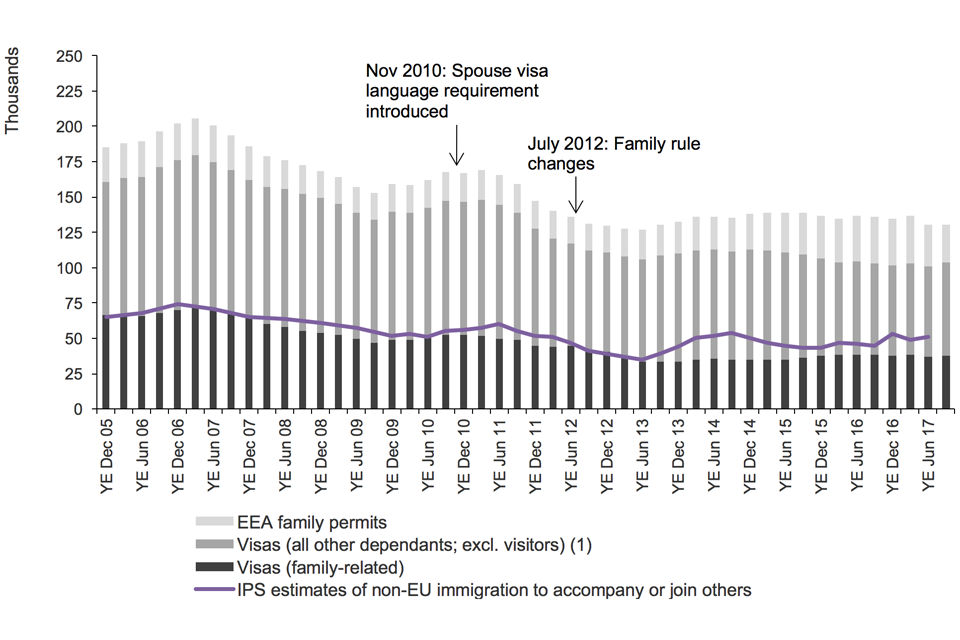Why do people come to the UK? (4) For family reasons
Published 30 November 2017
Back to Immigration Statistics July to September 2017 content page.
This is not the latest release. View latest release.
Data relate to the year ending September 2017 and all comparisons are with the year ending September 2016, unless indicated otherwise.
This section includes an overview of emerging trends on family-related visas. It also includes estimates of non-European Union (EU) long-term immigration to accompany or join (i.e. those intending to stay for at least 12 months to accompany or join others). In line with our plan to provide users annually with a more detailed commentary, a more detailed discussion of the figures was included in the Immigration Statistics April to June 2017 release Why do people come to the UK? (4) For family reasons Topic.
For figures on family-related grants of settlement as well as residence documentation issued to European Economic Area (EEA) nationals and their family members see How many people continue their stay in the UK?.
1. Key facts
The combined total number of family-related visas granted, including European Economic Area (EEA) Family permits granted to non-EEA nationals, and visas granted to dependants of other visa holders (excluding visitors) fell by 5,669 (4%) to 130,054 in the year ending September 2017.
In the year ending June 2017, estimates from the International Passenger Survey (IPS) showed that 51,000 non-European Union (EU) nationals immigrated long term to the UK to accompany or join others, that is with the intention of staying for a year or more. This was not a statistically significant change on the previous year (46,000). However, statistics on those arriving to accompany or join others are not directly comparable with visa statistics.
2. Family immigration: latest trends
| Year ending September 2016 | Year ending September 2017 | Change | Percentage change | |
|---|---|---|---|---|
| Family-related visas granted | 38,276 | 37,839 | -437 | -1% |
| of which: | ||||
| Partners | 29,159 | 30,349 | +1,190 | +4% |
| Children (1) | 2,779 | 2,154 | -625 | -22% |
| Other dependants | 6,338 | 5,336 | -1,002 | -16% |
| All dependants on other visas (excl. Visitor visas) | 64,384 | 65,961 | +1,577 | +2% |
| EEA Family permits granted | 33,063 | 26,254 | -6,809 | -21% |
| Total (family-related visas granted, all dependants on other visas excl. Visitor visas, EEA Family permits granted) | 135,723 | 130,054 | -5,669 | -4% |
| Year ending June 2016 | Year ending June 2017 | Change (2) | Percentage change | |
| ONS estimates for non-EU long-term immigration to accompany or join others (3) | 46,000 | 51,000 | +5,000 | +11% |
Table notes
Source: Home Office, Immigration Statistics July to September 2017, Visas table vi 01 q (Visas volume 1), Office for National Statistics (ONS), Migration Statistics Quarterly Report.
(1) This category does not include children of a parent given limited leave to enter or remain in the UK for a probationary period. They are included in ‘All dependants on other visas (excl. visitor visas)’.
(2) The increase had an estimated confidence interval of +/-12,000.
(3) Immigration to accompany/join others data are estimates of the number of non-EU nationals intending to change their residence to the UK for at least 12 months based on the IPS. Latest 12 months for long-term immigration to accompany or join others data are to the year ending June 2017 and are provisional.
3. Long-term trends in family immigration
IPS estimates of non-EU immigration of those accompanying or joining others in the UK include those arriving on Family visas, as well as persons accompanying those who are arriving for other reasons, such as for work or study.
The chart below shows that IPS estimates of immigration to accompany or join others have over the long term followed a broadly similar trend to the total number of visas granted by the Home Office through the Family route and to other dependants. IPS estimates are substantially lower as they exclude people who come to the UK but intend to stay for less than a year. Both measures of immigration for family reasons / to accompany or join others have generally fallen over the long term since the year ending March 2007, albeit with short-term increases in 2010 and again in 2013.
Long-term trends in family immigration

Chart notes
Source: Home Office, Immigration Statistics July to September 2017, Visas table vi 04 q (Visa volume 1); ONS (provisional estimates for year end to June 2017), Migration Statistics Quarterly Report.
(1) Includes all dependants (such as dependants for work and study), but excludes visitors.
4. Data tables
Data on family immigration, sourced from Home Office administrative systems, can be found in the following tables:
Visa tables volume 1
Visa tables volume 2
Visa tables volume 3
Admissions tables
Extensions tables
Settlement tables
